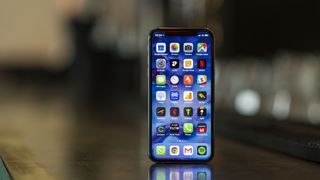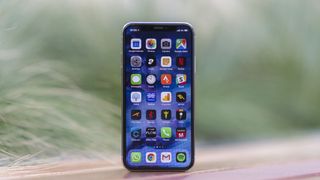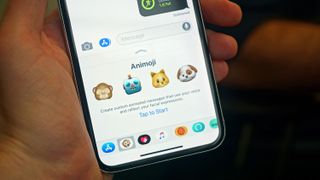The iPhone X is the huge leap forward that Apple's handsets needed after ten years, and it's even better in 2018 thanks to a more stable iOS 11.3 update. Aside from the original iPhone in 2007, this new iPhone is having the biggest impact on Apple’s smartphone direction ever.
Apple itself is calling it the future of the smartphone, the embodiment of what it’s been trying to achieve for a decade. But while the iPhone X is all about premium parts and an all-new experience, it’s a huge gamble for the Cupertino brand too, as it tries to reclaim some leadership in smartphone innovation.
Losing known, reliable elements like the Touch ID fingerprint scanner, the home button; introducing new methods of navigating and unlocking the phone – and charging a lot more for the privilege – seems risky for a company that was already treading new ground by doing away with the traditional headphone jack last year.
But the iPhone X is the handset we’ve been demanding from Apple for years – a world away from the increasingly-tired designs that those who just want a new iPhone have had to make do with.
Watch our review the of the iPhone X's design below.
The fervor around this phone tells that story
y – everyone wants to know if the new iPhone X is worth having, partly because it actually represents a new iPhone, and that fervor is such that they don’t seem to care about the cost.
So… is the iPhone X worth having? Will it change the direction of an industry where many of the specs Apple has put in – fast charging, wireless charging, bezel-less displays and face recognition – are already on the market?
We've had the iPhone X in our grasp for a more than six months now, and it's easily one of the best smartphones around - but there are still a few things that might throw even long-time Apple fans.
iPhone X specs

Weight: 174g
Dimensions: 143.6 x 70.9 x 7.7 mm
OS: iOS 11
Screen size: 5.8-inch
Screen Resolution: 1125x2436
CPU: A11 Bionic
RAM: 3GB*
Storage: 64GB / 256GB
Battery: 2,716mAh*
Rear camera: 12MP+12MP (both OIS)
Front camera: 7MP
*According to Chinese filings
iPhone X price and release date
- Now available; released on November 3 worldwide
- The most expensive flagship phone on the market
- Comes in 64GB and 256GB storage sizes
But, while the focus here is going to be on the technology, we still need to at least mention the price and release date. It's out now, having launched worldwide on November 3. The price is harder to swallow.
The iPhone X costs $999 / £999 / AU$1,579 for the basic, 64GB model. If you want the larger 256GB model it’s going to cost you $1,149 / £1,149 / AU$1,829 for the privilege.
Word is that Apple said to be launching a cheaper LCD iPhone variant for 2018, what we're calling the iPhone 9 for now, as Apple looks to bring the bezel-less form factor to a lower-cost, non-OLED variant... but that's strictly rumor for now.
The initial issues with stock are now over, and you can grab the handset in a a number of ways - with the iPhone X colors pretty limited this year, and the option of two storage sizes your main choices.
Screen
- By far the best screen on an iPhone
- Clear, vibrant colors
- Notch at top slightly irks, but doesn’t get in the way
The 5.8-inch OLED display is, quite simply, the best thing Apple has ever crammed into an iPhone. It’s leaps ahead of the iPhone 8 and 8 Plus for so many reasons: the sharpness, the quality, the fact that it fills the whole front of the phone, and the color reproduction.
It’s also using a new, longer, screen, but while it looks larger than the iPhone 8 Plus’ 5.5-inch display on paper, it’s only marginally bigger in terms of actual screen real estate – it’s just stretched upwards, so it's taller, not wider.

The stretched screen is a completely different experience on the iPhone X
Some will point to the fact that Samsung has been using OLED screens on its phones since the first Galaxy, but Apple counters that by saying it’s only now that the technology is good enough for its phones.
On the face of it that sounds defensive, but when you use the iPhone X you can see it’s a screen that’s incredibly, well, Apple.
It’s not the sharpest or most colorful screen on a smartphone, but it’s clean, crisp and doesn’t suffer from terrible color shifts when you move it around. It’s a great display to look at from all angles, and that’s what you want on a mobile device.
It's also been dubbed the best in the world, by the esteemed DisplayMate testing, showing that it's the brightest and more color-accurate OLED on the market and good off-centre brightness shifts - showing Apple can tune the tech from Samsung really well.
The term ‘bezel-less’ has been bandied about for the iPhone X, but that doesn’t really tell the right story. Yes, there are slight bands around the edges of the screen as this isn't a curved screen iPhone, but they don’t mar the experience – they give the fingers something to land on, preventing accidental touches of the screen.
Apple could reduce these further in the future and offer a more visually-appealing iPhone, but on the X the experience is still striking.
Talking of visual appeal, the notch at the top of the iPhone X is something that’s been divisive, and that’s fair. Apple has taken this little chunk out of the top of the screen to house the new TrueDepth camera, and it encroaches on the display. A lot newer Android phones, including the oneplus six, copy this style.
In portrait mode it’s hard to notice it’s there, and the way the notifications bar spills around it is nice.
However, place the phone in landscape mode and it’s far more noticeable; it’s an irritant when you’re watching movies, as when we wanted to expand them to fill the screen (one of the real beauties of having a longer display) elements of the action were cut out by the notch.
The longer screen is also thinner though - this means there's less real estate for typing. We didn't notice this at the start, but when flipping between the X and an older iPhone, you'll really see there's less space for your digits to tap onto.
While we’re talking about that longer screen, the 18:9 format is something we’ve seen on a number of other phones this year, and in the Android world the apps are largely encoded to fill the display just fine.
On the iPhone X, however, that’s not the case, with many apps we used packing massive black bars above and below the display. That's quickly started to improve though, and each day more apps update for the longer screen.

Native apps have a space below the keyboard where the home button would have gone
The new display on the iPhone X also showcases a new feature for Apple: HDR playback. The phone can show movies encoded in the HDR10 and Dolby Vision formats, and combined with the OLED display the images offer so much more depth and realistic color reproduction.
If you’re watching a scene with explosions in it, the effect is incredible on the iPhone X – much like with all OLED screens.
However, it’s inherently harder to make out detail in darker scenes in HDR movies – that’s something you’ll need to adjust to.
Compared to the LCD screen of the iPhone 8 Plus, there are times when you can see less of the action, but compare them side by side and you’ll see that the overall richness, depth and quality for watching movies is just higher on the iPhone X.
Like the iPhone 8 and 8 Plus, the X uses a True Tone display, which mimics the lighting conditions around it and will adjust the white balance accordingly. It’s not a reason to buy the phone on its own, but it’s a really premium little extra
ليست هناك تعليقات:
إرسال تعليق